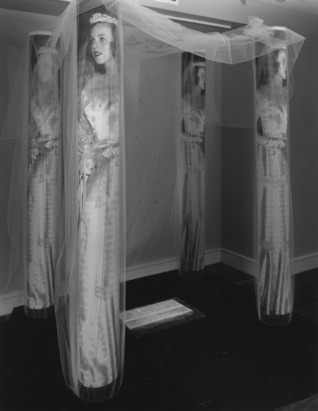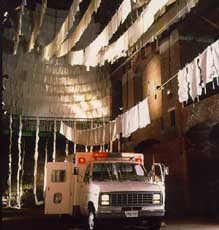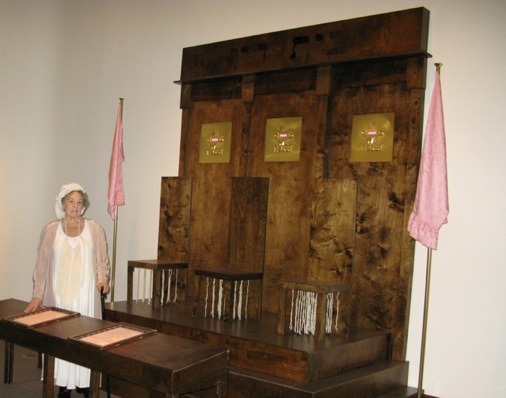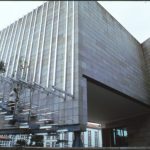Helène Aylon & Feminism: A Fiscally Sponsored Artist Reflects
“Art History has been one incomplete truth, which makes it a lie.”
Helène Aylon is a visual artist, feminist and mother. Born to an Orthodox Jewish family in Borough Park, Brooklyn, Aylon married a rabbi when she was eighteen and was widowed at thirty. Left with two young children, Aylon began studying and making art. Her contributions to contemporary art were honored last month with a Lifetime Achievement Award from the Women’s Caucus for Art. She is the author of “Whatever is Contained Must Be Released: My Jewish Orthodox Girlhood, My Life as a Feminist Artist.” Aylon is also the recipient of two NYFA Fellowships in 1988 and 1993 and four Pollock Krasner Foundation grants. Her work has been exhibited in numerous museums, including the Whitney, San Francisco Museum of Art, Berkeley Museum and the Andy Warhol Museum. I am delighted to welcome Aylon to NYFA Current to celebrate her achievements and Women’s History Month.
MC: You began taking courses at Brooklyn College when your daughter entered kindergarten. What fueled your decision to study art and how did your mother and father respond?
HA: My mother would rave about the birthday cards and Jewish New Year cards I designed for her and would introduce me as her “daughter the artist” to distinguish me from my two younger sisters. I knew that my mother surely had a different concept of art. Perhaps she thought it might even be a plus when I came of marriageable age! But her designation, no matter the derivation, was encouragement enough for me.
I yearned to express myself and live my life on my terms. Before, I did what my parents dictated, what my teachers dictated, what my late husband dictated, what the community dictated and thus [this is] what my children came to expect. Art would be something they could not dictate.
I played down my secret thrill of attending Brooklyn College as an art student, though I felt much older than the other students. In this way my father could rationalize that I was getting a college degree so I could teach art and get a job.

MC: How did you support your children and negotiate the demands of motherhood with your work as an artist?
HA: Always my children came first and my art came next, but the art would not be compromised.
I tried a NY Times ad: working at an ad agency. I soon got fired. I tried to get a job as a guard in the Metropolitan Museum but they saw right through me. I applied for grants. I got into one of the first Soho galleries, Max Hutchinson Gallery. Then, before my exodus to California, I signed up with Betty Parsons Gallery.
I taught for a few years in San Francisco State University which was my excuse for getting far away. I would sublet my studio when in San Francisco and also when I went to retreats such as Yaddo, Macdowell, VCCA, to avoid paying rent and still have a place to make art.
My uncle thought I should design wallpaper, my late husband’s teacher thought I could fake an accent and get a job advertising on TV. I would feign interest but ignore these "practical” suggestions [and] continue to struggle.
After my job was over and I did not get tenure at San Francisco State (see my memoir for why!), I no longer could afford the studio where I created the liquid sacs that broke. Nuclear America became my studio when I drove the Earth Ambulance to ‘rescue’ the earth from nuclear military sites in pillowcase sacs.
It was never smooth sailing and the situation has barely improved, even now, after getting a Lifetime Achievement Award on my 85th birthday last month. My small studio has become a storage space. I am now able to create art around activist work, but I have not a clue how to find a gallery. Betty Parsons found me and so did Max Hutchinson and Susan Caldwell. What gallerist will find me now?????
MC: The obstacles you faced and are currently battling seem to resonate with other artists. Where do you find the motivation to sustain your practice?
HA: I am motivated to learn for myself in ways that only art can teach.

MC: Questions about the body, ritual and the passage of time are themes within your work. They are explored by excavating your childhood, Judaism and/or feminism through a series, such as Paintings That Change and the The G-D Project. How did you begin working in series and what draws you back to this process?
HA: I tend to work for ten years on an issue of the day [with] a feminist lens on that issue. In the 1970s it was about the body changing and the body of the land, biological feminism. The abstracted female torso of The Breakings was an answer to the Playboy culture that does not see the body as something that makes us live or die, and give birth, sweat and gush and drip. In the 1980s the issue was ecological feminism with the earth and disarmament. These issues all still exist but in the 1990s [my focus became] theological feminism with The G-d Project: Nine Houses Without Women.
MC: Since beginning your career in 1960’s New York, you witnessed transformations to the art scene, the fabric of the city and cultural perceptions of feminism. How have such social and cultural changes influenced your studio practice? What do you think the landscape for emerging artists is today, in comparison to when you began exhibiting work?
HA: Emerging women artists have more opportunity to be seen and hopefully will change the culture if they see the legacy bestowed upon them with appreciation.
The greatest nonviolent revolution has been Feminism. I am focusing on the tragedy of lost foremothers we will never know and what their great contributions might have been. I see myself as a future foremother. Art History has been one incomplete truth, which makes it a lie.
MC: What artists inspired your work when you were beginning to make art and what artists are you looking at now?
HA: Then, my teacher at Brooklyn College was Ad Reinhardt, who did not teach but made me think. There is no “how to” and each artist must find the answers in oneself or ask the questions to oneself. But what gets me going is where I left off in my own last piece.
Now I like to look at Agnes Martin who said that “helplessness is the natural state for an artist and this is a good thing.” I relate to Ana Mendieta and dedicated my installation Wrestlers to her. I am drawn to Mierle Ukeles (who in the early ‘80s jokingly called herself and me “Mitzva Artists”), William Kentridge, Martha Rosler, Maya Linn, Bill Viola, and then there is Glenn Ligon… In 1996 Glenn Ligon wrote to me that he liked my "austerity” in The Liberation of G-d. But I am so blown away by his emotional splotches in his work. I wish I did not have to contain myself politely when it comes to my emotions about the misogyny and the erasure of the female. But I must “austerely” allow the viewer to be the Midrashist as the text I use is scripture, which is supposedly the words of G-d…

MC: The G-D Project has been fiscally sponsored since 1999. The work explores the way God has been used in the Old Testament to reflect patriarchal characteristics. Why did you initially seek sponsorship and how has sponsorship made this project possible? How did The G-D Project evolve over the past seventeen years?
HA: It was hard to deal with this very personal subject matter. G-d can be a potentially inflammable volatile subject. Calling it a “project” through NYFA neutralized it so that it could be looked at as an artwork. Furthermore, seeing G-d through a feminist lens became tagged as theological which made it easier to absorb. These subtle factors took away any sermonic stance that brings out tensions. Working through NYFA thus set the tone for exploration and radical truth-telling which is the realm of artists.
The G-d Project used my background to deal with feminist issues such as inequality. I find that theological feminism has not yet been dealt with, as has biological feminism and ecological feminism. The San Francisco Jewish Museum programmed “Four Rabbis and an Artist: A Talmudic Debate"! Yes, I took on Orthodox, Conservative, Reformed and Reconstructionist rabbis! The National Museum of American Jewish History in Philadelphia, Hammer Museum in LA, Andy Warhol Museum in Pittsburgh and Ackland Art Museum all programmed this debate with Rabbis from their communities. The Liberation of G-d and the Unmentionable has been the subject of a conference and the thesis of a PHD and [these] theological public debates were viewed as activist Performance Art.
I am now organizing the nine “Houses” without women of The G-d Project for a mini retrospective, and writing an art book on this project which would serve as a catalogue [and] I am also making one more installation. This year I showed My Wailing Wall, which is 30 feet, in a five artist show at Rider University in New Jersey, [as well as] Written Behind My Back, My Eternal Light, and Self Portrait: The Unmentionable.
In Jerusalem women judges are forbidden to judge in the religious Court, which is the subject of All Rise. A patron has offered to pay for its transportation to Jerusalem if it will be shown in the Jerusalem Biennale in 2017. I am holding my breath as this has the potential to affect change.
– Interview by Madeleine Cutrona
NYFA’s Fiscal Sponsorship program works with artists and emerging organizations to raise funds using NYFA’s tax-exempt status as a 501©(3)-classified organization. Learn more here.
Images, from top: Self Portrait 2005, from Self Portraits 2005-2007, photo credit: Helène Aylon; My Bridal Chamber: My Marriage Contract, 1999, photo credit: JCC/DC; Earth Ambulance, Brooklyn Bridge Anchorage, 1992, photo credit: Mal Varon; All Rise, 2007, photo credit: Betty Lane




